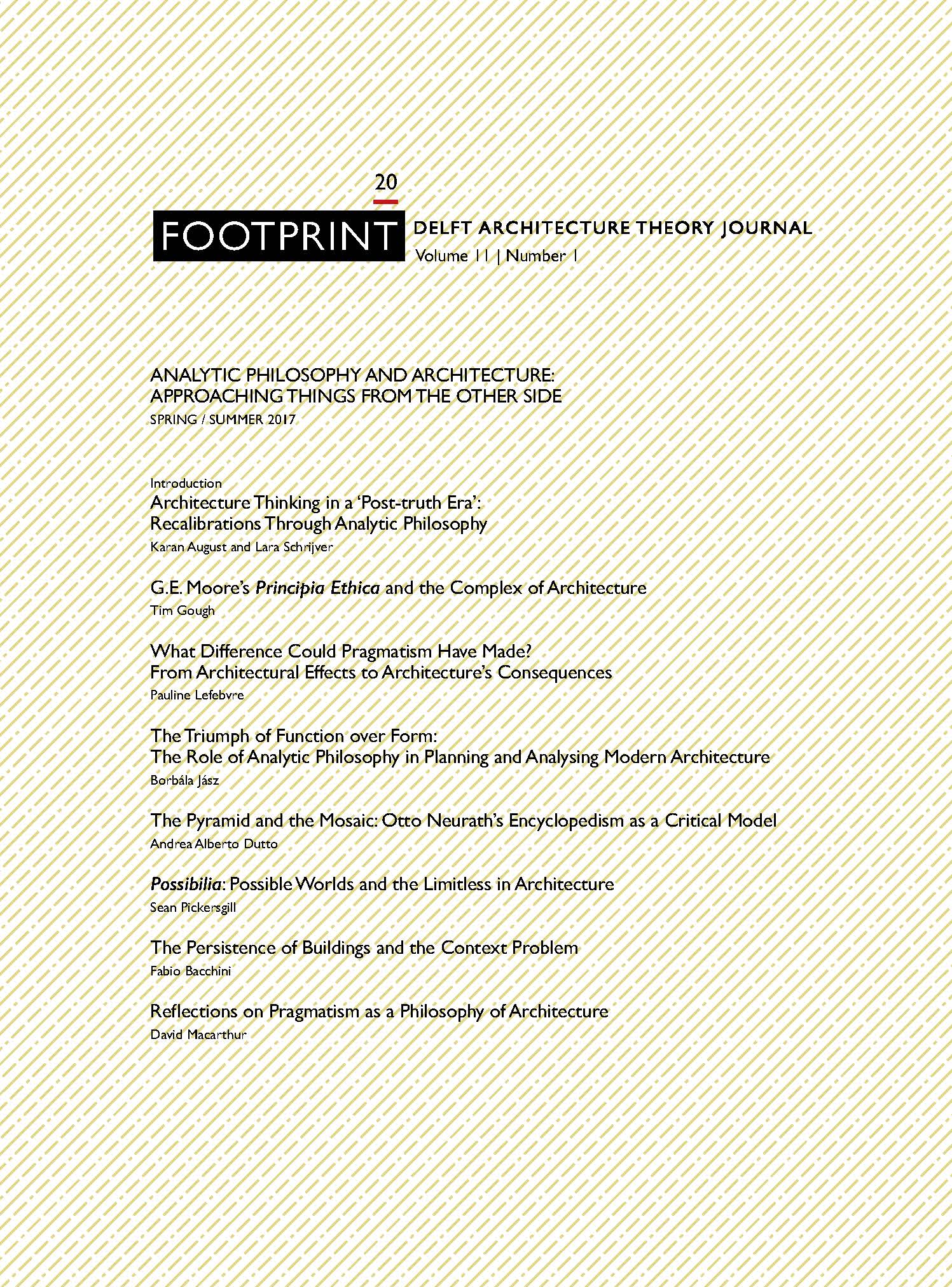The Triumph of Function over Form The Role of Analytic Philosophy in Planning and Analysing Modern Architecture
DOI:
https://doi.org/10.7480/footprint.11.1.1187Abstract
The most dominant dialectical succession of architectural thinking during the 20th Century was between form and function. The latter of these two modern ways of architectural thinking is based on the results of Carnapian Neopositivism. The keywords of this philosophical school, that are empiricism, logic, verification, unity of language and science, could still be applied to interpreting modern architecture. I will explain the antecedents and the first connection between analytic philosophy and architecture, and some characteristic points of their influence during the 20th Century: the triumph of function over form as analogous to triumph of analytic philosophy over metaphysics.
After the theoretic grounding of the form-function debate, I am going to focus first on the characteristic appearance of form: the Façadism of Socialist Realism in the architecture of East-Central Europe. Second, I will explain that architectural tendencies of classical modernism did not disappear in this period, they were just hidden in case of public buildings or migrated to the industrial planning. Third, I am going to claim that after this socialist realist gap, the architectural theory and planning tendencies of the interwar period – especially the work of Le Corbusier – returned and continued.
References
Banham, Reyner. Theory and Design in the First Machine Age. Cambridge MA: The MIT Press,1980.
Boyer, M. Christine. Le Corbusier, Homme de Lettres. New York: Princeton Architectural Press, 2011.
Branczik. Marta and Markus Keller. Korszerű lakás 1960: Az óbudai kísérlet. Budapest: Budapest Történeti Múzeum, 2011.
Galison, Peter. “Aufbau/Bauhaus: Logical Positivism and Architectural Modernism,” Critical Inquiry 16 (1990): 709–752.
Gero, Andras and Janos Poor. Budapest: a History from its Beginnings to 1998. New York: Columbia University Press, 1997.
Hahn, Hans, Otto Neurath and Rudolf Carnap, The scientific conception of the world: The Vienna Circle. Dordrecht: Reidel, 1973. 317¬-318.
Hays, K. Michael (ed.). Architecture Theory since 1968. Cambridge: The MIT Press, 1998.
Heathcote, Edwin. Budapest: a guide to twentieth-century architecture. Michigan: Ellipsis, 1997.
Josephson, Paul R. Would Trotzky Wear a Blootooth? Technological Utopianism under Socialism, 1917–1989. The John Hopkins University: Baltimore, 2010.
Khruschiev, Nikita. “Industrialised Building Speech, 1954,” Archis 3 (2009).
Kuhn, Thomas. The Structure of Scientific Revolutions. Chicago: University of Chicago Press, 2012.
Le Corbusier et Pierre Jeanneret. Oeuvre Compléte de 1910-1929. Zurich: Les Éditions d’Architecture Artemis, 1974.
Le Corbusier. The City of To-morrow and Its Planning. New York: Dover, 1987.
Le Corbusier. Toward an Architecture. Los Angeles: Getty Research Institute, 2007.
Loos, Adolf. “Ornament and Crime,” in Programs on Manifestoes on 20th-century Architecture, ed. Ulrich Conrads (Cambridge, The MIT Press, 1971).
Mallgrave, Harry Frances. Modern Architectural Theory: A Historical Survey, 1673–1968. Cambridge: Cambridge University Press, 2005.
Molnar, Virag. Building the State: Architecture, politics, and state formation in post-war Central Europe. Abingdon: Routledege, 2013.
Mumford, Eric. The CIAM Discourse on Urbanism,1928¬–1960. Cambridge MA: The MIT Press, 2000.
Rowe, Colin and Fred Koetter. Collage City. Cambridge, MA: MIT Press, 1978.
Sullivan, Louis H. “The Tall Office Building Artistically Considered” Lippincott's Magazine (March 1896): 403–409.
Weiner, Robert. Change in Eastern Europe. Westport: Praeger,1994.
Zarecor, Kimberly Elman. Manifacturing a Socialist Modernity: Housing in Czechoslovakia, 1945–1960. Pittsburgh, Penn.: University of Pittsburgh Press, 2011.
Downloads
Published
Issue
Section
License
- Authors retain copyright and grant the journal right of first publication with the work simultaneously licensed under a Creative Commons Attribution License that allows others to share the work with an acknowledgement of the work's authorship and initial publication in this journal.
- Authors are able to enter into separate, additional contractual arrangements for the non-exclusive distribution of the journal's published version of the work (e.g., post it to an institutional repository or publish it in a book), with an acknowledgement of its initial publication in this journal.





